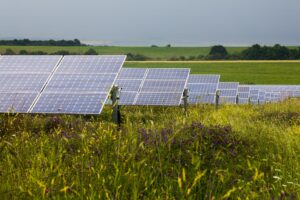Today nearly 200 solar and storage companies sent a letter to congressional leaders calling for legislation to improve permitting, project siting, transmission, and public lands access for solar and solar plus storage projects.
Market forecasts show that a range of policy and economic outcomes will determine the volume of solar deployment over the next decade, including regulatory factors and the pace of transmission capacity buildout. Companies across the solar and storage value chain are calling on lawmakers to put forward permitting and siting reforms that can sustain the industry’s growth trajectory.
“There are hundreds of billions of investment dollars that depend on our ability to get clean energy projects sited, permitted and efficiently connected to a modern transmission system,” said Abigail Ross Hopper, president and CEO of the Solar Energy Industries Association (SEIA). “Lawmakers in both parties understand the importance of getting new energy infrastructure built quickly and efficiently. Now is the time for policy action to strengthen America’s energy industry and support local economies with jobs and private investments.”
The 200 companies recommend the following reforms:
- Modernize Federal Energy Permitting: Streamline and standardize the permitting process at the federal level, while supporting environmental safeguards.
- Create Project Siting Partnerships at All Levels of Government: Encourage federal, state and local authorities to work together to identify and designate appropriate sites for clean energy development, including on underutilized and disturbed lands.
- Build Out Transmission Capacity: Invest in transmission planning, build out, and grid modernization efforts to maximize transmission capacity and unlock the full potential of solar energy, especially in remote regions with abundant solar resources.
- Enable Administration to Reach Public Lands Goals: Simplify the process for clean energy generation and transmission projects to access public land leases while maintaining environmental conservation standards.
- Foster Interagency Collaboration: Empower federal agencies with siting authority — like the Federal Energy Regulatory Commission, Bureau of Land Management, and Department of Energy — to create a central clearinghouse for permit applications to ensure a streamlined approval process for critical transmission infrastructure.
According to forecasts from Wood Mackenzie, the solar industry could reach 673 GW by 2034, but there is a 200 GW difference between the high- and low-case solar deployment forecasts.
If Congress fails to act on permitting and siting reform, communities could lose out on billions of dollars and tens of thousands of jobs.
“Permitting reform at the federal level and significant transmission system investment are essential to our national energy security,” said Amanda Smith, vice president for external affairs for AES’ U.S. renewables business. “AES has more than 50 gigawatts of clean energy projects in our U.S. development pipeline. Many of these projects are ready to move forward and will generate critical economic investment and create jobs in local communities across the country, but they require swift permitting action and transmission infrastructure upgrades to ensure we can advance a clean, reliable energy future.”
“Our current laws are not set to enable our nation to build generation and transmission at the scale needed to support our economic growth,” said Virinder Singh, vice president of regulatory and legislative affairs for EDF Renewables. “For example, the Western U.S. needs more solar on federal lands to meet its reliability needs. We can do it, and while heeding environmental and community priorities. But we need federal leadership to match the moment.”
“A lack of transmission capacity is the biggest barrier to the continued growth of the renewable industry,” said David Mindham, director of regulatory affairs for EDP Renewables North America. “The proposed reforms will remove these barriers, creating thousands of new American manufacturing jobs and supporting local economies.”
“Pine Gate calls upon Congress to improve energy infrastructure permitting as we prepare to invest billions of dollars to advance positive economic growth and support local communities across the country,” said Maggie Sasser, vice president of government and external affairs for Pine Gate Renewables.
Read the letter and the list of companies urging Congress to act on siting and permitting reform.

